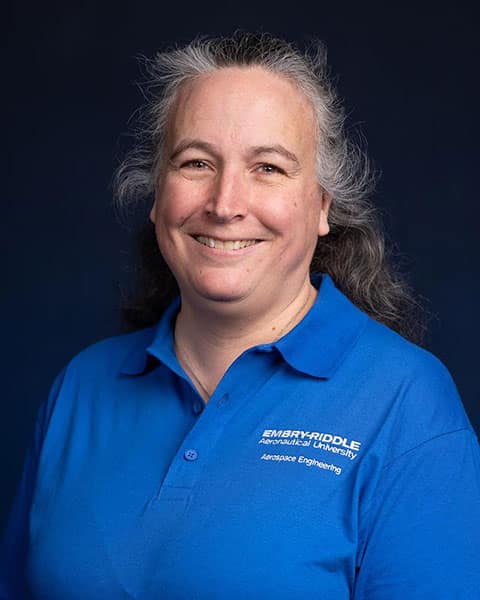
Embry‑Riddle’s Aerospace Engineering (AE) Department is the largest in the country, with 2,322 Bachelor of Science students, 93 Master of Science students and 72 Ph.D. students as of Fall 2024. It should be noted that about 10% of our undergraduates are honors students, compared to about 5% for the rest of the ERAU Daytona Beach campus. In addition, we continue to have numerous design/build/test projects at both the undergraduate and graduate levels.
I am also proud to report that the undergraduate AE program continues to rank very highly at No. 5 in the nation, according to “U.S. News and World Report” rankings (September 2024). This is a significant accomplishment and demonstrates the program's quality. The graduate program also continues to thrive, ranking No. 28 in April 2024 and second in Florida. Currently, we have 26% female students and 24% underrepresented minorities in our B.S. program, which is higher than the national average for Aerospace Engineering programs.
Our research activities have been increasing significantly, with research expenditures more than tripling over the last five years. Some notable current and recently awarded external projects are:
- NASA University Leadership Initiative (ULI): “Safety-Aware Learning and Assured Autonomy for Aviation Applications”; PI: Dr. Hever Moncayo, co-PI: Dr. Merve Dogan
- ONR: "Bubbly Water Shielding for Jet Noise Reduction"; PI: Dr. Reda Mankbadi
- University Consortium of Applied Hypersonics (UCAH): Novel Low-Cost Long-Duration Measurements of Material Degradation in Hypersonic-Like Environments"; PI: Dr. Bill Engblom, co-PIs: Dr. Mark Ricklick and Dr. Seetha Raghavan
- NSF BRITE-Pivot: “Leveraging Light-Matter Interactions to Create New Functional Sensors in Low-Gravity Space Environments”; PI: Dr. Michael Kinzel
- NASA: “Fuselage Aerodynamics of the Dragonfly Lander on Titan”; PI: Dr. Michael Kinzel
- NASA ULI: “Safe, Low-Noise Operation of UAM in Urban Canyons via Integration of Gust Outcomes and Trim Optimization” (subcontract to University of Boston); PIs: Dr. Vladimir Golubev, Dr. Tasos Lyrintzis and Dr. Reda Mankbadi
Our students have been involved in many interesting projects. For example, Dr. Troy Henderson led student teams that designed hardware that was deployed on two recent space missions. The first project, EagleCam, was a camera payload onboard the Intuitive Machines Odysseus lander, which landed on the Moon in February of 2024. As a result, EagleCam was the first ever university project on the moon. The second project, LLAMAS, was a camera system deployed on the SpaceX Polaris Dawn mission in September of 2024. The department also participates in many collegiate competition projects undertaken by undergraduate students with notable successes, including these excellent accomplishments:
- 1st place in the AIAA Design, Build, Fly (DBF) 2023/24 competition, with 100-plus teams competing. Embry‑Riddle placed in the top three teams for three years in a row from 2022-2024, which is unpreceded.
- 2nd place in AIAA Engine Design Competition (2020)
- 1st place in the AIAA Individual Design Competition (summer 2017)
Our successes across these various areas are thanks to the guidance from very talented faculty who are leaders in their fields. In fact, a recent (10/24 for the 2023 year) Elsevier/Stanford study named several of our faculty among an international list of the world’s top 2% of scientists recognized for their career scholarly impact (excluding self-citations). There are 1,250 names in the Aerospace Engineering discipline. The following AE professors are recognized in this list: Dr. Gordon Leishman #30, Dr. John Ekaterinaris #220 (emeritus), Dr. James Gregory #346, Dr. Tasos Lyrintzis #468, Dr. Reda Mankbadi #791, and Dr. Riccardo Bevilacqua #1199. In addition, Dr. Ali Tamijani made the list for one-year impact (2023).
I am also proud to highlight the work of our researchers at the Eagle Flight Research Center (EFRC). The EFRC is an aerospace research and design facility that aims to further manned and unmanned flight through work related to alternative propulsion, flight control, autonomy and the development of novel aircraft. Currently, the EFRC is conducting research for sponsors such as the FAA and NASA, as well as for corporate partners and in-house initiatives. In the past year, the EFRC has offered 100-plus undergraduate and graduate students the opportunity to apply classroom learning in a state-of-the-art practical environment, guided by experienced faculty and staff with specialties in fixed- and rotary-wing flight dynamics and control, flight testing, aeroelasticity, electrical engineering, air-breathing propulsion, parameter identification and aerodynamics. Over the past five years, the EFRC has received more than $5 million in research grants and remains a hub for aerospace innovation.
Best Regards,
Dr. Anouck Girard
Professor and Chair
Contact Us
Daytona Beach, Florida 32114
